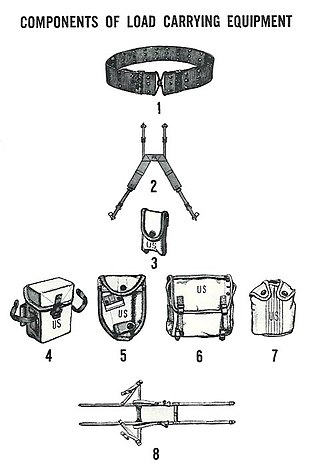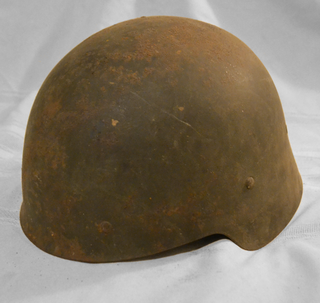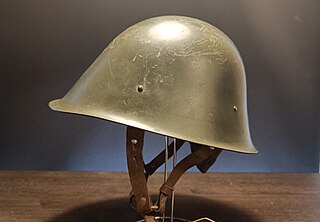
The Brodie helmet is a steel combat helmet designed and patented in London in 1915 by Latvian inventor John Leopold Brodie. A modified form of it became the Helmet, Steel, Mark I in Britain and the M1917 Helmet in the US. Colloquially, it was called the shrapnel helmet, battle bowler, Tommy helmet, tin hat, and in the United States the doughboy helmet. It was also known as the dishpan hat, tin pan hat, washbasin and Kelly helmet. The German Army called it the Salatschüssel. The term Brodie is often misused. It is correctly applied only to the original 1915 Brodie's Steel Helmet, War Office Pattern.

The Stahlhelm is a term used to refer to a series of German steel combat helmet designs intended to protect the wearer from common battlefield hazards such as shrapnel.

The M1 helmet is a combat helmet that was used by the U.S. military from World War II until 1985, when it was succeeded by the PASGT helmet. The M1 helmet has become an icon of the US military, with its design inspiring other militaries around the world.

Imperial Japanese Army uniforms tended to reflect the uniforms of those countries who were the principal advisors to the Imperial Japanese Army at the time.

In ice hockey, players use specialized equipment both to facilitate the play of the game and for protection as this is a sport where injuries are common, therefore, all players are encouraged to protect their bodies from bruises and severe fractures.

The M-1956 load-carrying equipment (LCE), also known as the individual load-carrying equipment (ILCE), was developed by the U.S. Army and first issued in the early 1960s. The M-1956 LCE was designed to replace the M-1945 Combat Pack, the M-1923 cartridge belt, the M-1936 pistol belt and the M-1937 BAR magazine belt. The M-1956 LCE was designed to be quickly configured, using no tools, to accommodate various mission and ammunition loads. The M-1956 LCE remained in service through the 1980s and set the standard for future United States military load-carrying equipment.

The Mk III Helmet is a steel military combat helmet that was first developed for the British Army in 1941 by the Medical Research Council. They were issued to troops in April 1944 and then worn in combat for the first time by British and Canadian troops on D-Day. Mk III helmets were used alongside the Brodie helmet for the remainder of the Second World War, with the former's successor, the Mk IV, serving with the Army well into the late 1980s. It is sometimes referred to as the "turtle" helmet by collectors, because of its vague resemblance to a turtle shell, as well as the 1944 pattern helmet.

The M/1923 helmet was a combat helmet issued to Danish troops during the interwar period and saw service in the Second World War. It was the first helmet to be issued to the Royal Danish Army and Navy. The helmet was produced by the Danish company A/S Glud & Marstrands Fabrikker.
The OR-201, also designated Kasda OR-201 Model 76 or M-76 for short, is a combat helmet of Israeli origin. Developed in the 1970s, the OR-201 was one of the world's first ballistic helmets. It was subsequently exported on a large scale and has been used by many militaries worldwide.

The Gefechtshelm M92 is the standard issue combat helmet of the Bundeswehr, first fielded in 1992 as a replacement of earlier M1956 steel helmets that were previously used during the Cold War. It is made from Aramid composite materials and is used by all branches of the Bundeswehr.

The m/37 helmet is a military steel combat helmet used by Swedish armed forces. Replacing the m/21 helmet, the m/37 would be modernized in 1965 with an updated liner and see use into the 1990s with its replacement by the M1990 Kevlar helmet. Three main variants existed. The first had a three pad liner system, like the m/21 and m/26 before it. The third, most common versions of the modified helmets had the same liner as the pictures but with a canvas chinstrap with a quick-release system. The helmet could be gray, as it always was during the second world war, or painted green as it often, but not always, was during the cold war.

The M32 helmet also known as M32/34 is a military steel combat helmet used by Czechoslovakia from its adoption in 1932 to its annexation by Nazi Germany in 1939. The helmet also being used by the Slovak Republic and Finland among other countries that the helmet would be worn by.

The M1918 helmet is a steel military combat helmet used by Switzerland from its introduction in 1924 to its replacement by the M1971. In 1940 improvements would be made to the design to which it would be called the M1918/40; and in June 1943, the color change in Black. The helmet would be seen used by Swiss servicemen until the late 20th century.

The M1942 helmet is a military steel combat helmet used by Spain from its adoption in 1942 to its replacement by a Spanish M1 copy in the 1980s.

The M1921 Helmet, also known as the M21, along with “Sin ala” for its vertical sides, is a steel combat helmet developed alongside the M1926 helmet in 1926 for use by the Spanish Army. The model was never formally adopted, with the army deciding in favor of the M1926. The exact reasoning for the designation "M1921" is not known as it was developed later.

The M70 is a steel combat helmet used by Hungary, a license made copy of the Soviet SSh-40 and further development of the previous model M50 helmet.

The M1934 helmet is a steel combat helmet used by various factions in the Spanish Civil War. Not meant for use by the Spanish Army, but instead by security forces such as police, the helmet was of similar shape to the Model 1926 helmet in use by the army. The helmet was mainly used by the rebelsFrancoist in the conflict.

The M34 is a steel combat helmet used by the Netherlands from its introduction in 1934 replacing the previous M23/27, to the invasion by Nazi Germany in 1940. From which it was replaced by the M53 helmet, a local copy of the American M1 helmet. A tropical variant of this helmet was produced for use by the Dutch East India Army in present-day Indonesia known as the KNIL model.

The Model 1973 is a Romanian steel helmet used by the army of Romania, introduced in 1973 in the Army of the Socialist Republic of Romania.

The Hełm wz. 67 is a combat helmet used in the Polish People's Army and in the Polish Armed Forces.



















